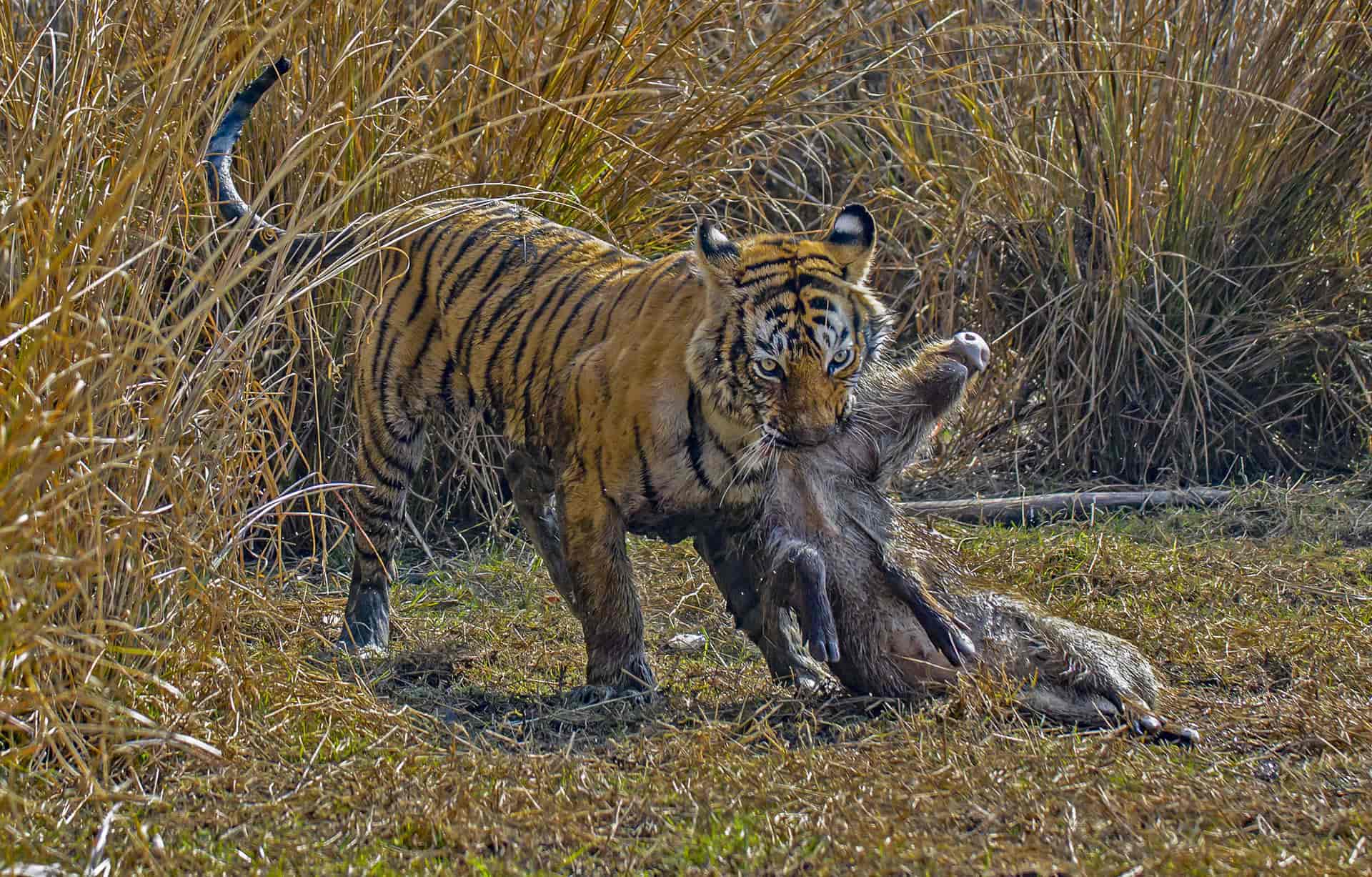Royal Bengal Tiger is the major attraction of the National Park in Nepal. The estimated population of the Royal Bengal tiger is 235 as per 2018 census data. Royal Bengal Tigers are also known as Panthera Tigris. Royal Bengal tiger is the subspecies of the tiger family which is found in Nepal, Bangladesh, India, Myanmar, and Bhutan. Among these regions, Indian has a large number of Royal Bengal Tiger which is around 2500 in today’s date.
With the signature orange fur and black stripes, tigers have become icons of beauty, power, and the importance of conversation. Tigers have evolved into six subspecies. The tiger’s tale of evolution can be traced back about two million years ago when the earliest known Tiger ancestors left Africa and ventured into Asia.
Over time, the big cat split into nine subspecies with six still alive today. Among them, the numerous tiger subspecies are Royal Bengal Tiger. It is among the total 50 % of the total tiger population worldwide.
Royal Bengal Tiger is the largest cat species on the entire planet with a lifespan of 18 to 25 years. As adults, the Bengal tiger comes in as one of the biggest and heaviest. Tigers of all weighing anywhere between 240 to over 500 pounds with most of them weighing around 420 pounds. However, the female of them is very small weighing only about 310. Here we discuss the amazing facts about the Royal Bengal Tiger below.
Table of Contents
Characteristics of Royal Bengal Tiger
Royal Bengal Tiger is also called Pate Bagh in Nepali and is found in Chitwan National Park, Bardia National Park, Suklaphanta National Park, Paras National Park, and Koshi Wildlife Reserve. The Bengal tiger is famous for its orange and black stripes which don’t match with each other and are unique on its own. The length of an adult Tiger is around 2.5 meters up to 3.5 meters. Unlike other wild animals, Royal Bengal Tiger has only 30 Teeth which is bigger and powerful compared to other carnivorous animals.
Royal Bengal Tiger Hunting and Prey
Bengal tigers are one of the wildest animals in the jungle which depends upon the other small animals for living and hunting. The skin and the color help Royal Bengal Tiger to get lost in the forest for hunting and prey. Tigers often attack the neck of animals until they die and then start to eat them. One Royal Bengal Tiger can eat up to 40 KG meat in one sitting.
Tigers don’t attack large animals for their meal but depend upon the small and medium-size animals like Deer, Chital, Wild boar, Wild Buffalo, moose, species, pigs, cows, horses, buffalos, and goats. Another amazing fact about the Royal Bengal Tiger is its tongue which roughness will shed away feathers and fur so the tiger can get straight to the meat. During the high-speed chase, Tiger’s tail is used to balance the body and paws to drag the animal and instantly attack the neck with sharp jaws.
Royal Bengal Tiger Behavior
Male Royal Bengal Tiger loves to live freely compared to other wild animals like hurdlers. Unlike Male, females Bengal tigers are accompanied by cubs depending upon the number of given births. During mating, we can see male and female tigers together with each other for a short time. The female tiger can give birth from 2 to 6 cubs at once which remains with the mother until 18 months. After 18 months, they can hunt on their own for small animals. And also they will be still attached to their mother for 2-3 years and then only they will vanish in search of their own territories.
Tigers used to travel for a long distance for food into their own territories. They lie and wait till the victim animals come close enough to attack.
Royal Bengal Tiger Marking Territories
Male Royal Bengal Tigers don’t stay in groups and create their own territories. Bengal tigers normally used to mark their territories in four major ways. Spraying Scent, Clawing Trees, Marking Scrapes and Urine are the major ways tigers used to mark their area.
Tiger’s territories are their home where they used to hunt, play and roam around. It is believed that tigers used to have a mental print of location which helps them to hunt wild animals.
Tigers inform each other of their whereabouts through complex scent markings that contain pheromones. They do this by spraying on trees, or any relevant spot during their regular movement through their territory. Tiger scat (poo) or scrapes (with their hind feet) also leave behind scent residues, which may function as cues to the tiger’s presence.






